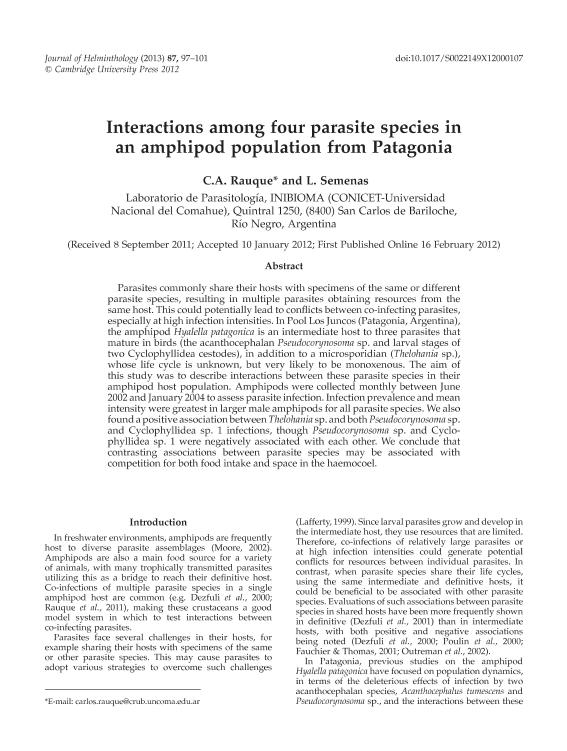Artículo
Interactions among four parasite species in an amphipod population from Patagonia.
Fecha de publicación:
01/2013
Editorial:
Cambridge University Press
Revista:
Journal Of Helminthology
ISSN:
0022-149X
Idioma:
Inglés
Tipo de recurso:
Artículo publicado
Clasificación temática:
Resumen
Parasites commonly share their hosts with specimens of the same or different parasite species, resulting in multiple parasites obtaining resources from the same host. This could potentially lead to conflicts between co-infecting parasites, especially at high infection intensities. In Pool Los Juncos (Patagonia, Argentina), the amphipod Hyalella patagonica is an intermediate host to three parasites that mature in birds (the acanthocephalan Pseudocorynosoma sp., and larval stages of two Cyclophyllidea cestodes), in addition to a microsporidian (Thelohania sp.), whose life cycle is unknown, but very likely to be monoxenous. The aim of this study was to describe interactions between these parasite species in their amphipod host population. Amphipods were collected monthly between June 2002 to January 2004 to assess parasite infection. Infection prevalence and mean intensity was greatest in larger male amphipods for all parasites species. We also found a positive association between Thelohania sp., and both Pseudocorynosoma sp. and Cyclophyllidea sp. 1 infections, though Pseudocorynosoma sp. and Cyclophyllidea sp. 1were negatively associated with each other. We conclude that contrasting associations between parasites species may be associated with competition for both, food intake and space in the haemocoel.
Palabras clave:
Parasites
,
Amphipods
,
Interactions
Archivos asociados
Licencia
Identificadores
Colecciones
Articulos(INIBIOMA)
Articulos de INST. DE INVEST.EN BIODIVERSIDAD Y MEDIOAMBIENTE
Articulos de INST. DE INVEST.EN BIODIVERSIDAD Y MEDIOAMBIENTE
Citación
Rauque Perez, Carlos Alejandro; Semenas, L.; Interactions among four parasite species in an amphipod population from Patagonia.; Cambridge University Press; Journal Of Helminthology; 87; 1; 1-2013; 97-101
Compartir
Altmétricas




